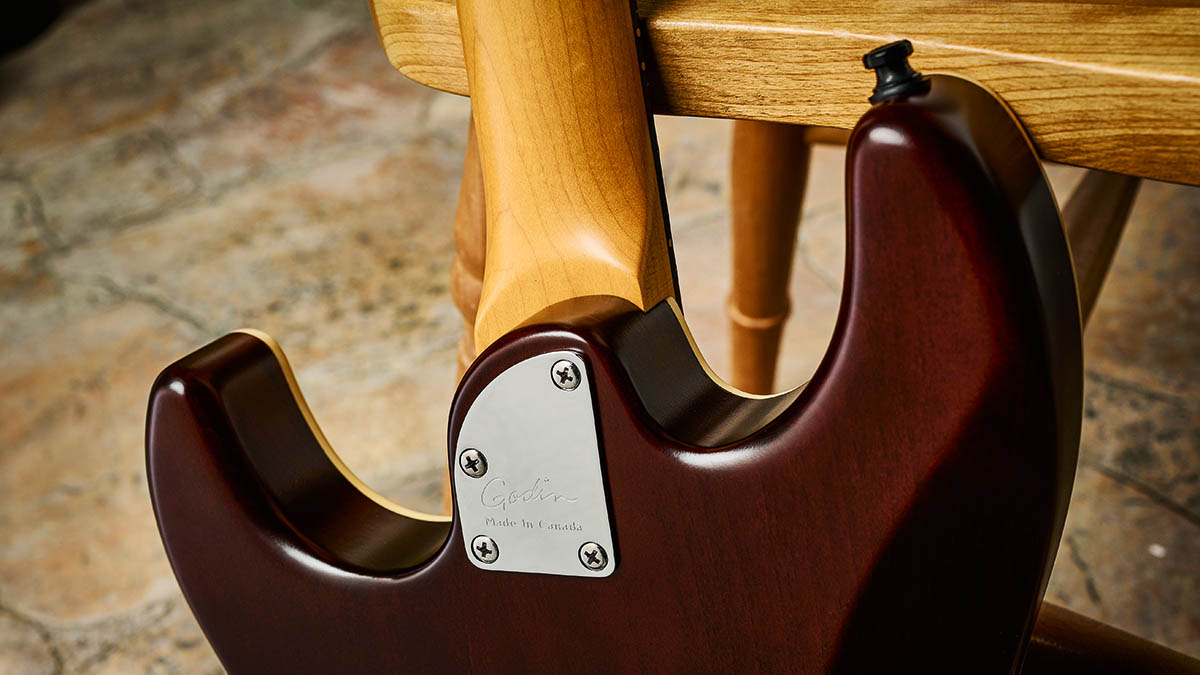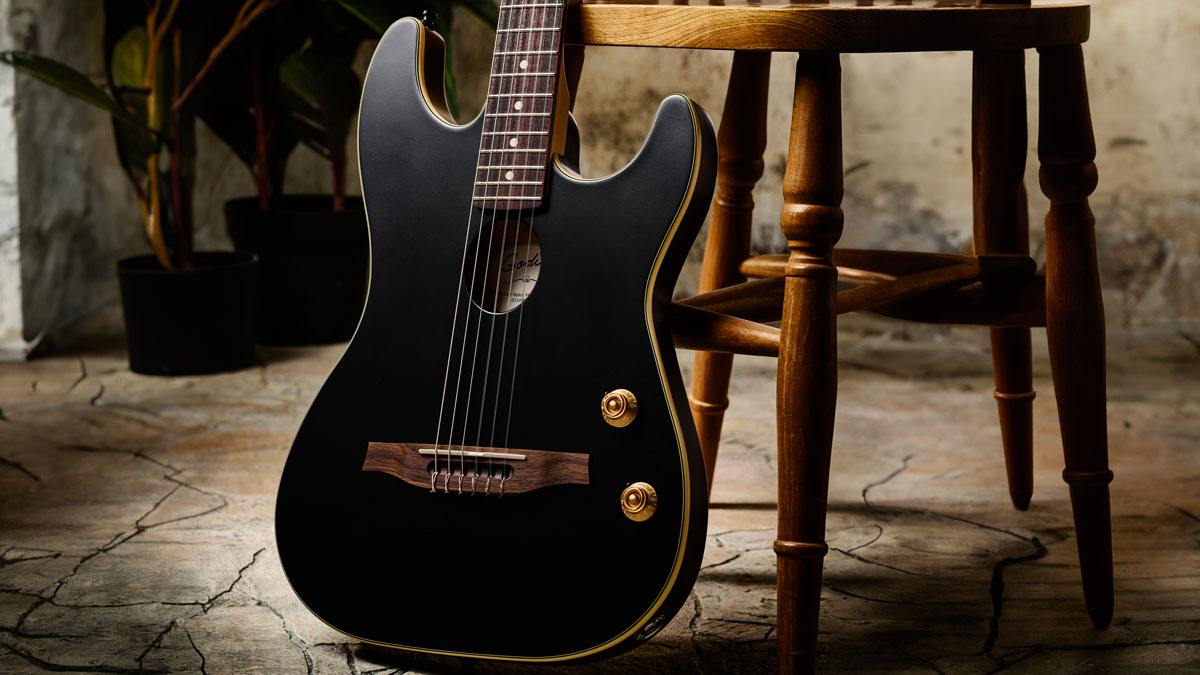Guitar World Verdict
Mixing up the styles as the G-Tour does is always going to create a polarising result. While the build is of a pretty high standard, the G-Tour will more likely appeal to the electric player who fancies some nylon sound, with a pick, and for that it’s a simple drive and very fit for purpose
Pros
- +
Smart lightweight build.
- +
Strong output.
- +
Simple controls.
- +
Well-voiced tone control.
- +
A nylon-string for the electric player.
Cons
- -
Narrow neck and string spacing will be too cramped for some.
- -
Seems expensive.
You can trust Guitar World
Godin is an expansive brand – other house brands include Norman, Seagull, and Simon & Patrick – we have regular steel- and nylon-string acoustics and electros, stage-aimed ‘crossover’ models such as the long-running Multiacs, instruments for ‘world’ musicians, and an extensive range of hollow, thinline, and solidbody electrics.
Before we get to look at some of the new-for-2024 models, we managed to get our hands on a pretty unique model that launched recently: the G-Tour. This instrument – the latest in a long line of stage-aimed nylon-strings that lie within Godin’s range – certainly blurs the line between the electric guitar and the nylon-string acoustic electric guitar.
The term ‘crossover’ is often used for such modernist excursions – for example, a nylon-string with a narrower neck, a cambered fingerboard, and often a thinner-depth body – but the G-Tour is more a thinline, mainly hollow, electric with nylon strings.
Here, we have a matt black top finish with dark brown-stained back and sides, which have a more satin finish. The modern Stratocaster-inspired body has a solidbody depth of 47mm and employs a solid cedar, lightly braced flat top with a silver leaf maple back that’s heavily chambered and braced. The top-edge is bound; the small soundhole isn’t. On the back is a pretty sizable ribcage contour.

The neck continues the classic electric vibe, screwing to the body via a neckplate that’s shaped to match the contoured body heel. It’s also a 22-fret neck with a standard Fender scale, only a couple of millimetres shy of the standard 650mm classical guitar scale length, and has a 305mm (12-inch) fingerboard radius.
Unusually, while the tuners appear to be regular die-cast types, they have plastic roller string posts as you’d find on a classical guitar, although there’s no slotted headstock here and they stick up at right angles to the headstock face, which is rather odd.
We even get a couple of electric-like string trees and a large open hole to access the dual-action truss rod. Aside from the nylon strings, the only other classical reference is the tie-block rosewood bridge with its compensated Graph Tech Tusq saddle.

Unusual for a thinline electro, though not unique, are the top-mounted volume and tone controls with Gibson-style top-hat knobs and those rather archaic (and unnecessary) pointed position indicators.
There’s no information on the actual circuit used here, aside from the fact it’s an under-saddle EPM Q-Discrete (also called a Quantum Discrete) system that’s used by Godin on plenty of other models. There’s a separate cavity for the battery that sits on the back cover plate over a rectangular hole, which is necessary to install the electronics.
The output is on the side on a cleanly installed Electrosocket-type mounting. Removing that cover plate, you can peer inside and see the thin top bracing. To call the guitar chambered is understatement; the body routing is considerable, leaving a pretty thin back, and sides that aren’t much thicker.
Feel & Sounds

Not surprisingly, then, it’s a very light guitar, weighing just 2.26kg (4.97lb), and for any electric player it feels very familiar played seated or strapped on. But if you’re used to the wider neck, even of a contemporary ‘crossover’ nylon-string, you might struggle a little.
The nut width is Fender electric-like at 42.35mm with a string spacing of an electric-standard 35mm, whereas the spacing at the bridge is even narrower than Fender-standard at 53mm.
Our sample needed a truss rod tweak to straighten the slight forward bow, and with virtually zero relief the string height drops to approximately 2.23mm on the high E, measuring 2.55mm on the low E, which is very low for the style but seems to be the key.

The neck itself has a slightly V’d profile, which suits thumb-around playing and is very different from a classical-style shape. Likewise with the medium-gauge and well-polished frets – plus, of course, we have easy access to the top of the fingerboard.
While there’s not much acoustic volume, plugged into our AER acoustic guitar amp we’re met with a strong output, louder than either of our Yamaha and Córdoba nylon-electro references, in fact.
There is a subtle centre detent on both the rotary controls, which seems a good place to start, rather than with both full up. The string-to-string output is pretty well balanced, and the G string slightly hot. Perhaps not surprisingly, the bass end isn’t the biggest we’ve heard, but that’s probably not a bad thing, especially for ensemble or band situations.

The midrange is a little more forward than either of our references, but that’s easy to balance outboard from either our AER’s controls or an additional dedicated preamp. Just remember: aside from the tone control, you have no onboard EQ help.
The tone control actually works very well, not least if you start in that centre mid-position where turning the control clockwise adds a treble lift that’s not over-harsh, a little more flamenco perhaps, and turned anti-clockwise the response is more mellow with a usable character shift.
While it takes a little adjustment with the spacing and the nylon strings, the quality of sound here is very good. We used a Carl Martin Acoustic GiG multi-effect pedal, which is quite the perfect match, particularly with its tuner, EQ, compression, and tap-tempo delay. Gradually, the G-Tour begins to make a lot of sense.
Verdict
Mixing up the styles as the G-Tour does is always going to create a polarising result. While the build is of a pretty high standard, the G-Tour will more likely appeal to the electric player who fancies some nylon sound, with a pick, and for that it’s a simple drive and very fit for purpose.
If you’ve already entered the nylon-string world via a classical guitar or a more modern ‘crossover,’ however, you simply might find the electric-like neck width and string spacing way too cramped. But, of course, Godin has plenty of options with nylon‑electro models that have wider necks and more expansive dual-source pickups and EQ to choose from.
It’s not a cheap date, either, but you can’t help applauding Godin for trying something a little different – something the company has done plenty of times over the years.
Specifications

- PRICE: $1,399 / £1,749 (inc gigbag)
- ORIGIN: Canada
- TYPE: Thinline double-cutaway, electro nylon-string
- TOP: Solid cedar
- BACK: Chambered silver leaf maple
- NECK: Maple, bolt-on
- SCALE LENGTH: 648mm (25.5”)
- TUNERS: Godin logo’d enclosed 14:1 ratio with plastic roller string posts
- NUT: Graph Tech Tusq
- FINGERBOARD: Rosewood, 305mm (12”) radius with face and side dot markers
- FRETS: 22, medium
- BRIDGE: Rosewood w/ compensated Tusq saddle
- ELECTRICS: Godin/EPM Q-Discrete under-saddle system with top-mounted volume and tone controls
- OPTIONS: Also available in Arctik Blue ($1,499/£1,829)
- RANGE OPTIONS: Another recent launch is the more ‘crossover’-style Multiac Mundial ($1,299 / £1,629) with dual‑source pickup system and choice of 4 colours
- LEFT-HANDERS: No
- FINISH: Matte Black (as reviewed), Arctik Blue
- CONTACT: Godin Guitars

Dave Burrluck is one of the world’s most experienced guitar journalists, who started writing back in the '80s for International Musician and Recording World, co-founded The Guitar Magazine and has been the Gear Reviews Editor of Guitarist magazine for the past two decades. Along the way, Dave has been the sole author of The PRS Guitar Book and The Player's Guide to Guitar Maintenance as well as contributing to numerous other books on the electric guitar. Dave is an active gigging and recording musician and still finds time to make, repair and mod guitars, not least for Guitarist’s The Mod Squad.
“I was playing in the living room, he walked past and shot me this look of ‘Do that again.’ So I bent the string up and he gave me this nod of approval”: Jack Moore on lessons learned from his father, Gary
“I heard the Money solo and thought, ‘This is amazing!’ So I sent David a telegram saying, ‘Remember me? I'm in a band now called Roxy Music’”: Phil Manzanera on his friendship with David Gilmour, and the key to the Pink Floyd man's unmistakable tone
“It’s really quite genius, but also hard to learn – it sounds insane, but sometimes the easiest songs still get me nervous”: Kiki Wong reveals the Smashing Pumpkins song she had the most trouble with











